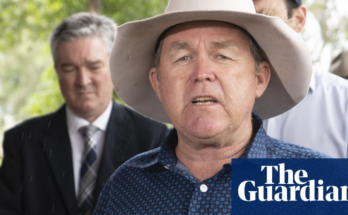It’s been a darkly entertaining celebrity bunfight between Rebekah Vardy and Coleen Rooney, but the light it shone on the nation’s online health should worry us all
Mid-way through his three-day, watch-through-your-fingers cross examination of Rebekah Vardy, Coleen Rooney’s theatrical barrister, David Sherborne, asked the following question: “Is this a joke or is it serious, Mrs Vardy? You can’t have it both ways. Serious or joke – which is it, Mrs Vardy?”
The question specifically concerned Vardy’s motivation in apparently wanting to leak to the Sun the story of her footballer husband’s former teammate Danny Drinkwater crashing his car with two female passengers in it and spending a night in a police cell (“I want paying for this,” Vardy told her agent, Caroline Watt). Even by that stage in the proceedings, however, you couldn’t help thinking that Sherborne’s inquiry applied equally to the entire spectacle of the eight-day “Wagatha Christie” trial (or “The Scousetrap”, as some prefer).
Vardy’s suit against Rooney, the claim that she had been defamed by her fellow WAG’s “sting operation” that allegedly exposed Vardy as the source of “private” information leaked to the tabloid press, concerned, on one level, the ludicrous weaponisation of extreme trivia. At the same time, though, this was a £3m case that occupied some of the sharper legal minds in the country for too many months, and which provided, for some papers, a week of front-page news at a time of economic turmoil and international crisis.
In summing up last Thursday afternoon, Vardy’s barrister, Hugh Tomlinson QC, suggested that “from Mrs Vardy’s point of view, whatever public entertainment has been afforded, this is an extremely serious case.”
If that claim were true, the import could be traced to the distorting effects of social media on received ideas of privacy and libel, and the lucrative ways in which those concerns now occupy so much public – and legal – space. Whatever the merits of Vardy’s case, there were a few times when you feared not only for her, but for the online state of the nation. One such moment was in Sherborne’s examination of Vardy’s response to one of Rooney’s private Instagram posts, a photograph of her driving her children to school in the rain.
Vardy has, as she pointed out, five kids in her own household, so her mornings are a bit crazy. Even so, Sherborne countered, she was attached enough to her phone and its privileged access to other lives, to be examining Rooney’s photograph, in some obsessive detail, at 8 o’clock in the morning. On seeing that post, Vardy immediately messaged her agent Caroline Watt to alert her to the fact that one of Rooney’s children appeared not to be wearing a seatbelt. Watt, with access through Vardy’s Instagram account, had already clocked the photograph herself. There was, in Sherborne’s telling, then some detailed discussion between the two of them as to whether this represented a story that might interest the Sun.
Eavesdropping on this exchange, (Vardy defended it as just friends gossiping), was a bit like overhearing the two most unhinged parents at the school gates discussing the mum (“that nasty bitch”) they most loved to hate. It was, too, a reminder that the bar for what might constitute a “story” in our social media age has fallen very low indeed. Sherborne was effective in showing how, in Vardy’s acknowledged dealings with the popular press, she had come to an understanding that a tale could be made – and sold – out of just about anything. Whatever her denials about the specifics of the case, it was clear that she would have made a natural tabloid hack.
Tomlinson, Vardy’s barrister, in the course of denying that his client was the proven source of the leaks in question, made a supplemental argument. There was, he claimed, no justification in Rooney’s desire to expose Vardy’s alleged betrayal, because the information leaked was in no real sense confidential. The stories in the Sun – about “flooded basements and minor car accidents” – did not involve state secrets or corporate fraud. They were things that might have been happily shared among Rooney’s friends. The case, he argued, was therefore not about harmful intimacies revealed but about “personal trust”. Rooney’s concern, he said, and her “unfair” publication of her suspicions about Vardy, was simply, in her terms, that someone “had provided that scum of a newspaper things to write about the Rooneys again”.
Tomlinson was right in some senses. This whole saga was less about privacy, than about privacy settings. The detective work, on all sides, involved not fingerprints and paper trails and forensics but zip files and media exports and intralinks. In a pre-digital age it might have been resolved by the two parties getting together to clear the air, or having it out over the phone. But what began on social media, inevitably perhaps, escalated exponentially on social media. Observing the fallout in court 13 of the Royal Courts of Justice, or in the standing-room only “overflow media room”, was to be reminded that a principal currency of our times is who chats what to whom.
One collateral effect of all this was to shine a light on some of the ways in which celebrity journalists have maintained access to their lifeblood – secrets of the rich and famous – since the “dark arts”, including phone hacking, have been outlawed. When tabloid papers first decided that gossip rather than news would be their stock in trade – you can trace the timing as Piers Morgan progressed from overseeing the Sun’s Bizarre gossip column to the editorship
of the Daily Mirror – it was in their interest to create fantasy worlds to report on. The royals were the prototype for what they called “fairytales”. The low-rent rivalries of millionaire footballers’ wives became a more reliable source of such stories.
The question then was, how to stand them up? With celebrity voicemails off limits, the addictive habits of Instagram and other social media came to their rescue. Despite the fact that she didn’t want any details about her family in the papers, Coleen Rooney never really questioned her need to send out frequent updates to her followers, curated edits of her fabulous lifestyle. After all, everyone else did.
What once might have been found by rifling through people’s bins, or blagging their personal details, was now there almost in plain sight. The temptation for someone with the required access to those tales to sell them on, Sherborne argued, was undeniable. Disloyalty might be traded for favourable coverage, or simply for money.
The curious dance between celebrities and their press agents and certain papers was at the heart of his case. The Sun journalists mentioned had opted not to be in court, claiming protection of sources, though presumably the reporter Amy Brookbanks would have liked the opportunity to counter Watt’s claim that: “She does whatever I ask her, and gets stories changed that she hasn’t even written.”
It was this kind of thing that Vardy’s husband, Jamie, speaking on the court steps, described as her “media work”. At one point, Vardy and Sherborne became mired in the details of a case in which a married footballer of her acquaintance had fathered a child with another woman. “If you believe everything written in the Sun,” Vardy said, laughing. “Is that funny, Mrs Vardy?” Sherborne asked.
Listening to Sherborne’s questioning it was tempting to believe that Vardy’s insider knowledge of the “game” of the celebrity world had also skewed other aspects of her life. Large parts of her testimony were taken up with attempts to define words which, in the age of social media appeared to have acquired new connotations. “She refused to accept the ordinary meaning of words, including ‘leak’,” Sherborne despaired, of the litigant’s difficulties with acknowledging that the word implied selling private information to the press. There seemed similar problems over the precise differences between “following” and “monitoring” and “stalking”. “The strange language you have with Ms Watt on WhatsApp that isn’t English,” Sherborne said at one point.
Watt was reportedly not in a healthy enough state to give evidence at the trial. Her absence – and that of the contents of her phone, which had been inadvertently dropped into the North Sea, not long after Rooney’s side had requested it in disclosure – was, it was suggested, “like Hamlet without the Prince of Denmark”. The implication of Vardy’s case, as it evolved, was that she probably blamed her former friend and agent for leaking the planted “fake” stories about Rooney, though she was “too loyal” to actually voice that conclusion explicitly. “Mrs Vardy has obviously made mistakes,” Tomlinson accepted. “The most serious was perhaps to trust Ms Watt…”
In the absence of the agent and the contents of her phone, the closest Sherborne had to a smoking gun proving Vardy knew that Watt was leaking stories from Rooney’s account, lay in one of her responses to a warning that Rooney put out on Twitter, before finally naming her prime suspect: “The car crash story is completely wrong,” Rooney wrote. “Someone on my private Instagram is selling stories… It’s sad to think someone, who I have accepted to follow me, is betraying for either money or to keep a relationship with the press.”
“It wasn’t someone she trusted, it was me.” Watt wrote bluntly to Vardy. Had Vardy admitted to seeing that message, Sherborne concluded, the game would be up. As it was, she said this had been one of the few times in her life when she was not apparently paying attention to her phone. She said she missed this message because she was bathing her children while watching Gemma Collins in Dancing on Ice.
It remains to be seen whether the long-suffering judge, Mrs Justice Steyn, will find enough in the evidence to support Vardy’s claim that she has been illegally wronged by Rooney. What is certain is that Vardy’s long days in court apparently achieved precisely the opposite of what she hoped, which was to stop the abuse and ridicule that she has been subjected to on Twitter and elsewhere. “Had Mrs Vardy known her conversations would be made known to the whole world these are things she would not have said,” Tomlinson noted.
As this trial has once again emphasised in all too painful detail, you can have all the privacy protocols in the world, but things said on social media have a habit of taking on a wayward life of their own.
{{topLeft}}
{{bottomLeft}}
{{topRight}}
{{bottomRight}}
{{/ticker}}
{{heading}}
{{#paragraphs}}
{{.}}
{{/paragraphs}}{{highlightedText}}
{{#choiceCards}}{{/choiceCards}}



